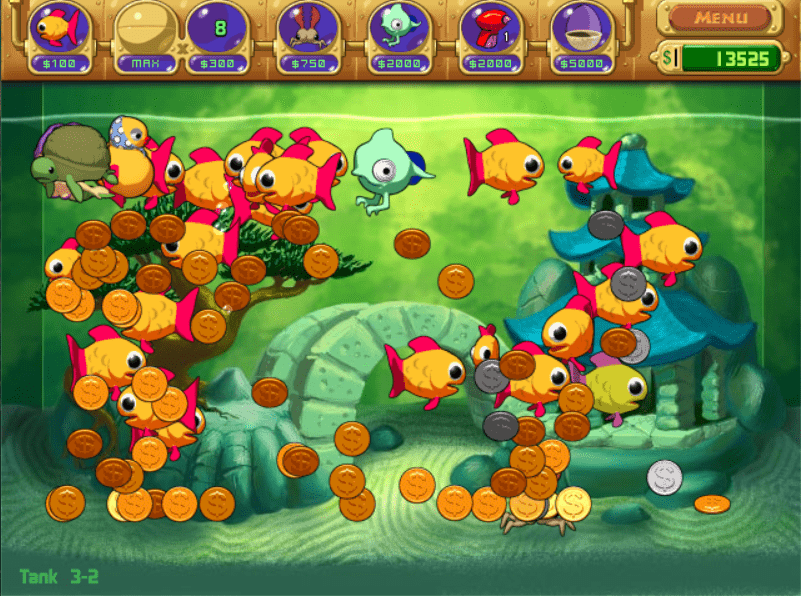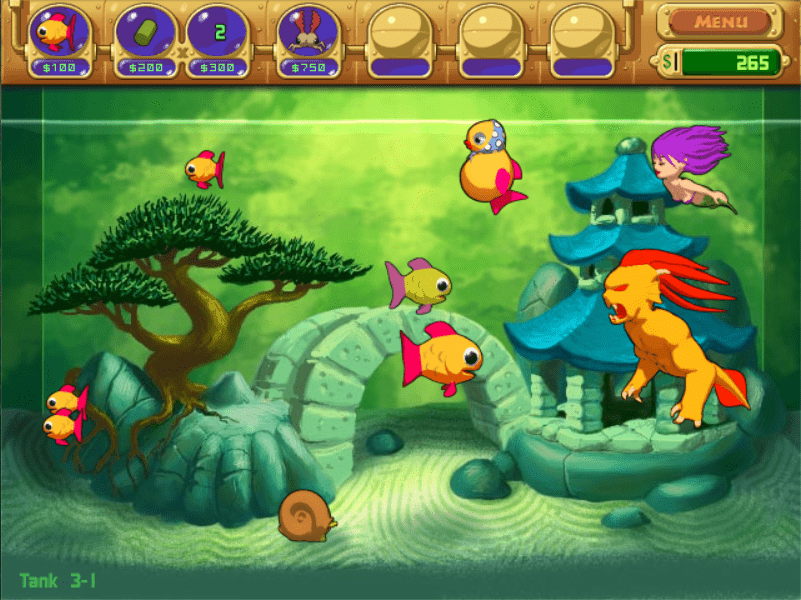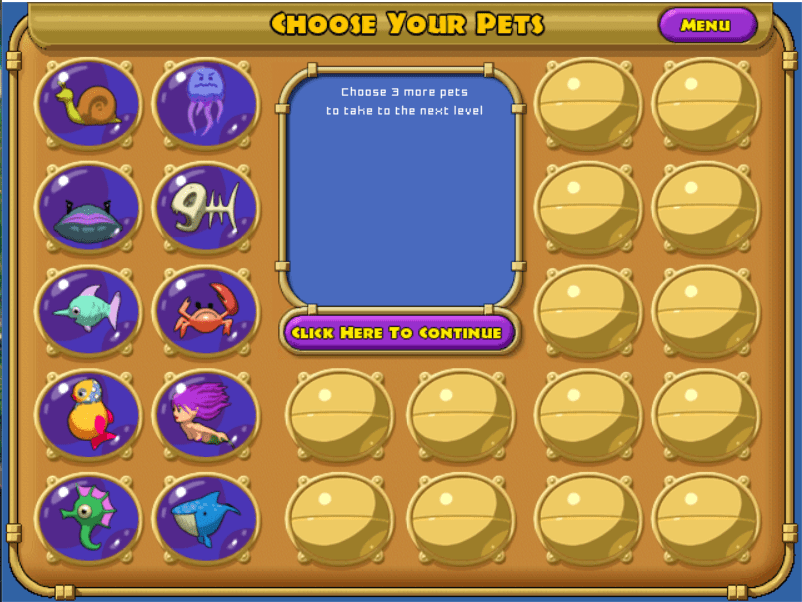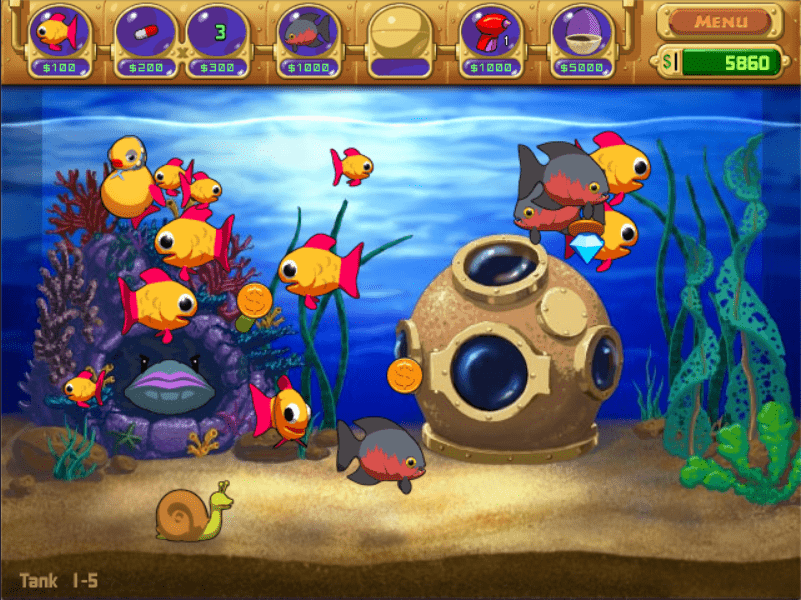Name of Game: Insaniquarium
Developers: PopCap Games and Flying Bear Entertainment
Platform: macOS, Windows, Java, Palm OS, Feature phone, and Windows Mobile
Target Audience:
Insaniquarium was originally released in 2001, and I first played it when I was around five years old. I was motivated to revisit the game after the sketchnote video for this week mentioned its onboarding process. Insaniquarium is easy to pick up at any age and from any level of experience with gaming. I feel that this is partially due to the fact that the game was developed during a time when PC gaming was still at its start, and many people were buying personal computers for the first time ever. Insaniquarium’s target audience upon release was someone who likely had an interest in gaming but didn’t have much experience using computers. You’ll find that most children at the time met these criteria. Since the game has re-released on Steam, I find that many of its players are adults who previously played the game as children and are lured in by the nostalgia factor. However, based on the numerous positive reviews, they still find Insaniquarium enjoyable today.
Formal Elements:
Insaniquarium provides simple mechanics that build satisfying gameplay loops. The game is broken into many short stages. In each stage, your goal is to collect three egg pieces and complete a full egg in order to unlock a new pet. You collect egg pieces by using coins to purchase them from an overhead shop. You earn coins through a few simple actions that make up a majority of the game. Most prominently, you manage your aquarium of fish. There are different types of fish that you can purchase (normal fish, carnivores, etc.), but you will need to feed all of them in order to have them stay alive and periodically drop coins. You must also collect the coins that the fish drop before they hit the bottom of the tank, or they won’t be added to your funds. Another way to earn coins is by fighting monsters that periodically appear in your aquarium. There are different types of monsters that appear, and each will require a different approach to defeat them. If a monster touches a fish too much, it will consume the fish. Upon defeat, the monsters drop diamonds which give more coins than any other drop. Lastly, you unlock pets that can help you with a variety of tasks throughout the game: collecting coins, fighting monsters, protecting fish, etc. There are a few types of pets that will periodically grant you coins.
One thing that really stood out to me was the fact that there were so many different types of actions that you can take using just a simple mouse click. For example, you can drop a food pellet into the aquarium by clicking on empty tank space, you can collect coins by clicking on them, you can make purchases from the shop by clicking on what you want, and you can click on monsters to deal damage to them. There was a lot of overlap in the function of the mouse click, and yet, it never felt confusing.

Types of Fun:
Insaniquarium offers fun through sensation and submission. A big appeal of the game is being able to look at the cute fish and pets as they swim around your aquarium. The game is also full of quirky, fun sound effects for every click you make. Lastly, there is the physical sensation of constantly needing to move your mouse around and spam the left-click as you try to keep your aquarium in order. The game offers fun through submission because once you understand the mechanics, you are able to manage your aquarium without much thought. You can set up a good aquarium at the start of each stage; then, it is only a matter of time until you farm enough coins to buy the egg pieces and move to the next level. The game is consistent and easy to play passively.
Moments of Success/Failure:
I thought the onboarding in Insaniquarium was particularly good. At one point, the game introduced the starcatcher (new fish type) and star potion (special food item). The star potion can be fed to a fully grown normal fish and will cause the fish to drop stars instead of coins. These stars can then be consumed by the starcatcher to produce diamonds. The catch is that if a guppy eats the star potion it will die. The game simply put both these items in the shop without explaining how they worked at all. I kept killing my guppies by feeding them star potions, and each time that a guppy died, the game gave me a hint on how to use the star potion. The more guppies that I accidentally killed, the more straightforward the hint became. It was fun to try to figure out how to use the items on my own while still getting help when I couldn’t figure it out.
One aspect that the game could improve on is its narrative. The monsters that spawn into your aquarium look very out of place with the overall aesthetic of the game. It raised a lot of questions from me as a player. Why are they there? Why do they want to eat my fish? Where do they come from? Why do I shoot them with a laser? The periodic appearances of the monsters never failed to feel jarring compared to the peaceful upkeep of your aquarium. I think this experience could have been smoothed out if they added some narrative that gives the monsters a reason to be invading your aquarium. The game is generally very good, but adding a stronger narrative is one change I would make.

Notes on Balancing:
Pacing is the change in difficulty over time throughout a single game. In Insaniquarium, the egg pieces that you need to collect in order to progress get more expensive as you beat more stages. This requires the player to find more efficient ways of running their aquarium and farming coins if they don’t want to spend an unreasonable amount of time on the later stages. I would describe the game as quite easy overall; however, I don’t think this is necessarily a problem with pacing. The player likely comes into a game like Insaniquarium with the expectation that the game won’t be very challenging. The difficulty starting point is shifted lower, but the rate at which the difficulty increases matches the expectations of the player.
Insaniquarium includes many different types of game objects, and I find that it has a fruity approach to trying to balance them. Focusing particularly on the pets that you collect, they serve very distinct functions that are hard to compare. For example, it is difficult to directly compare a whale that protects your guppies from monsters to a clam that periodically creates pearls that are worth a lot of coins. However, if we focus on the cost/benefit ratio of the pets, I think there are some balancing problems. Some functions are clearly more valuable than others, and there is little motivation to use the pets that don’t serve the most valuable functions. For example, it is very easy to spam click monsters and defeat them quickly, so you wouldn’t want to use the seahorse that helps you fight monsters. On the other hand, you want to keep your aquarium full of fish, so the pregnant fish that periodically pops out a new guppy is a great pet to use. There could have been some more attention to the balancing between game objects, but overall, it doesn’t impede on the game experience significantly.




